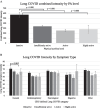Associations between physical activity, long COVID symptom intensity, and perceived health among individuals with long COVID
- PMID: 39507087
- PMCID: PMC11538967
- DOI: 10.3389/fpsyg.2024.1498900
Associations between physical activity, long COVID symptom intensity, and perceived health among individuals with long COVID
Abstract
Introduction: Physical activity (PA) is associated with better perceived health among individuals with chronic conditions. However, PA's relationship with perceived health in people with long COVID is unclear and may be modified by long COVID symptom burden.
Methods: Participants with self-reported long COVID (N = 379) responded to an online survey cross-sectionally assessing PA levels, perceived physical and mental health, and intensity of CDC-defined long COVID symptoms on a 0-100 scale. Linear regression analyses assessed the associations between PA and perceived physical and mental health, after accounting for sociodemographic, health behavior, and long COVID intensity variables, with post-hoc analyses comparing health across PA levels.
Results: Increasing levels of PA were associated with increases in perceived physical health (β = 0.27, p < 0.001) and mental health (β = 0.19, p < 0.001) after accounting for sociodemographic and health behavior variables. PA remained significantly associated with perceived physical health (β = 0.15, p < 0.001) but not perceived mental health (β = 0.09, p = 0.067) after the adding long COVID intensity to the model. Insufficiently active and active groups reported significant better physical and mental health than the inactive group (ps < 0.05), while the highly active group did not significantly differ from any other group on perceived physical or mental health (ps > 0.05). Inactive individuals reported significantly greater long COVID symptom burden compared to each other PA level (ps < 0.05).
Conclusion: Higher levels of PA may be associated with better physical health among individuals with long COVID, even after accounting for symptom intensity. However, long COVID symptom intensity may confound the relationship between PA and mental health among individuals with long COVID.
Keywords: exercise; long COVID; mental health; physical activity; physical health; post-acute sequalae of COVID-19.
Copyright © 2024 Sirotiak, Lee and Brellenthin.
Conflict of interest statement
The authors declare that the research was conducted in the absence of any commercial or financial relationships that could be construed as a potential conflict of interest.
Figures


Similar articles
-
Physical activity level and factors associated with perceived stress among Peruvian university professors during the COVID-19 pandemic.Heliyon. 2023 Jun;9(6):e16439. doi: 10.1016/j.heliyon.2023.e16439. Epub 2023 May 23. Heliyon. 2023. PMID: 37251478 Free PMC article.
-
The association between Long-COVID symptomology, perceived symptom burden and mental health in COVID-19 patients in Shijiazhuang, China: a population-based health survey.Front Psychiatry. 2024 Jan 26;15:1332066. doi: 10.3389/fpsyt.2024.1332066. eCollection 2024. Front Psychiatry. 2024. PMID: 38343619 Free PMC article.
-
Effects of COVID-19 on Physical Activity and Its Relationship With Mental Health in a US Community Sample: Cross-sectional, Convenience Sampling-based Online Survey.JMIR Form Res. 2022 Apr 4;6(4):e32387. doi: 10.2196/32387. JMIR Form Res. 2022. PMID: 35302509 Free PMC article.
-
Associations between different types of physical activity and teachers' perceived mental, physical, and work-related health.BMC Public Health. 2014 May 30;14:534. doi: 10.1186/1471-2458-14-534. BMC Public Health. 2014. PMID: 24885620 Free PMC article.
-
Physical activity in the context of advanced breast cancer: An integrative review.J Adv Nurs. 2021 May;77(5):2119-2143. doi: 10.1111/jan.14709. Epub 2020 Dec 14. J Adv Nurs. 2021. PMID: 33314310 Review.
References
-
- Araújo B. T. S., Barros A. E. V. R., Nunes D. T. X., Remígio de Aguiar M. I., Mastroianni V. W., de Souza J. A. F., et al. . (2023). Effects of continuous aerobic training associated with resistance training on maximal and submaximal exercise tolerance, fatigue, and quality of life of patients post-COVID-19. Physiother. Res. Int. 28:e1972. doi: 10.1002/PRI.1972, PMID: - DOI - PMC - PubMed
LinkOut - more resources
Full Text Sources

